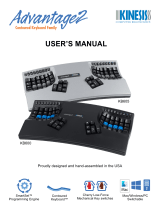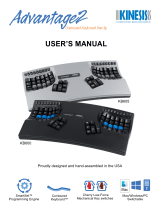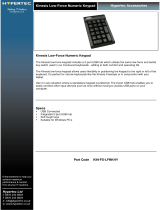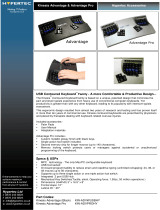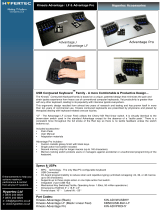Page is loading ...

SE2 Smart Set App User Manual - Version 1.2 for Windows & Mac
Introduction
This document is intended to help you use the latest
versions of the SE2 SmartSet
™
App to program your
Savant Elite2 Foot Pedal on either a Windows or Mac
computer. To access all Foot Pedal features it may be
necessary to download and install a firmware update for
your device:
Kinesis.com/support/savant-elite2/#firmware-updates
Refer to the full Savant Elite2 User’s for detailed
instructions on device usage:
Kinesis.com/support/savant-elite2/#manuals
Overview
Your Savant Elite2 (SE2) device uses a simple text file (pedals.txt) saved to its onboard memory to execute custom
keyboard or mouse actions with the press of a pedal or hand trigger (sold separately). The SE2 SmartSet App is a “no-
install” graphical application (“app”) designed to facilitate custom programming of your SE2 by eliminating the need to
directly edit the underlying text file.
Your SE2 device has its own virtual drive (v-drive™) named “KINESIS FP”. The v-Drive is only visible on your computer
when your SE2 device has been placed into Program Mode. Program Mode is accessed by sliding the recessed switch
on the underside of your SE2 device to “program mode”, or by depressing a pedal briefly while plugging in the device.
Each SE2 device comes pre-loaded with a Windows and Mac 32 Bit version of the SmartSet App. These versions of the
App are intended to be run directly from the v-Drive and should not be transferred to your PC. New versions of the App
may be available for download.
Mac users running the latest 64 Bit operating system will need to download a 64 Bit version of the SmartSet App in order
to program the pedal. The 64 Bit version of the SE2 SmartSet is too large to be saved directly from the v-Drive. Instead,
save it directly to your Mac and simply copy and paste the custom pedals.txt file to the v-Drive.
Kinesis.com/support/savant-elite2/#smartset-app
When you have completed your customizations, save your changes in the App, then slide the switch on your SE2
Elite2 device back to “play mode”. Note: when the v-drive is open, mouse-button actions are disabled.
Operating systems supported
Windows: XP, 7, 8, and 10
Mac: macOS 10.4+
International Users
The SE2 SmartSet App must be used with the U.S. keyboard layout (Windows users go to “keyboard” in Control
Panel/Region & Language)

2
Configure a pedal
1. If you want to preserve the previous actions, you should first copy the original pedals.txt file to a different
location or use “Save as” in the App before making any changes.
2. Click on any “configure” box to select an input to program. In Figure 2 below, the Left Pedal “configure” box
has been clicked and its “Configure” button is highlighted. The “edit box” on the right turns yellow with the
selected input (Left pedal) shown in blue.
3. Click the button for “Single Action” or “Multiple Actions (Macro)”
and type what you want the pedal to produce, or use your
mouse to select a special action from the drop down menu. Note:
Single Actions appear inside square brackets [ ] (red [ ] for
named keys like [tab]). To edit your entry, use the “Backspace”
button, not the backspace key on your keyboard, or click “Clear”
to start over.
4. Click the “Done” button to accept the changes. The action(s) will
appear in the appropriate gray box below. In this example, the
Left Pedal gray box will then show [tab] instead of [lmouse].
5. Click the “Save” button to save the edits to your pedals.txt
configuration file.
6. Close the v-drive or re-plug the device to implement your
changes. To close the v-drive, move the programming slide switch back to play mode.
Note: If you start to configure a pedal and click another “configure box” before you have clicked “done,” you
will get the message shown in Figure 4.
If you click “yes,” any changes you have entered will be applied to the current pedal or jack — if the yellow box is
empty, “yes” will erase what is previously saved for that box before making the next pedal or jack active for
editing.
If you click no, pending changes will not be applied before making the next pedal or jack active. “Cancel” will keep
the current pedal or jack the focus of the yellow “edit box.”
Figure 2. Configuring left pedal for a single action
Figure 3. Re-configure left pedal to perform “tab”

3
Using the “Special Actions” menu
For convenience a number of popular keyboard shortcuts have
been pre-defined. Special actions also include commands that
cannot be typed with a keyboard into the configuration editor (e.g.
“mute”). To browse the special actions, simply click the Special
Actions button for a drop down menu. Special actions can be used
on their own or in conjunction with other actions as part of a larger
multiple-action macro. See Table 1 (next page) for a full list of
special actions for both Mac and Windows. Explanations for many
of the special actions are included below.
Depending on the version of the SE2 SmartSet App you are running, your options may vary.
Detailed Help for Special Actions (use Special Actions drop-down menu)
Left mouse double click
The left mouse double click action also available from the “Special Actions” menu looks like this: [lmouse-dblclick].
It uses a 125ms delay between two mouse button actions. If this does not operate correctly on your computer, you
can experiment with different delays by manually creating a double click macro with the SE2 SmartSet App. For
example, you could program a left mouse click, then insert two delays of 125ms from the “Special Actions” menu.
The resulting macro would look like this in the App:
[lmouse][125][125][lmouse].
Web browser forward or back
These actions are dependent on the specific browser and operating system being used. If these pre-programmed
macros don’t work, you will need to experiment with what key commands are needed and then create your own
macro.
Alt+Tab and Cmd+Tab
Switching screens with a Alt (Windows) or Cmd (OS X) plus Tab is often useful. However, the user normally does
this by holding the Alt or Cmd key and repeatedly pressing and releasing the Tab key. When the SE2 special
action for Alt+Tab or Cmd+Tab is used on a pedal, it can only alternate between two screens.
Activate Windows key (Program a Win key combination in Windows version of App)
If you want to combine a Windows key action with another key (such as “Win + m” to minimize all windows), use
the “Activate Windows key” action from the drop down menu. This is a special case where you select the this
action, then type the key you want to combine it with. The resulting combination in the edit box will look like this:
[win+m].
Slow or fast output
If you program a macro and is seems to play too fast or too slow, you can insert a “Slow Output” or “Fast Output”
command at the beginning or anywhere within its contents. You can also subsequently insert the other output
speed command. For example, if you need to perform the macro “Alt = Enter” to autosum a column of numbers in
a spreadsheet, you might need the “slow output” feature which will appear as [slow][alt]=[enter]. However, delays
(see below) may work better in some environments than “slow output.”
Delays (125ms, 500ms)
Sometimes delays work better than the “slow output” feature. In the example above for summing a column of
numbers in a spreadsheet, a macro for “Alt = Enter” might work better for a particular OS or spreadsheet version if
it were constructed like this, with a 125ms delay before the “enter” command: [alt]=[125][enter].
Different press and release (macros)
This feature is useful if you want to be able to press and hold the pedal and not have the entire programmed macro
play until you release the pedal. This happens by default for a single key action, but a macro normally plays to
completion as soon as a pedal is pressed.
For example, to play F11 when a pedal is pressed and F12 when it is released:
1. First click the pedal or jack you wish to program.
2. Then click the “Multiple Actions (Macro)” button.
3. Type the F11 key to produce [F11] in the yellow box.
4. From “Special Actions” select at the bottom, “Different Press & Release” to insert: [{ }].
5. Then type the F12 key, which adds [F12] after the [{ }] token.
6. Click “Done” and [F11[{{ }][F12] will be saved for the appropriate pedal or jack.
7. When you are done programming, click “Save” and exit from Programming Mode to implement your changes.
Figure 4. Changing configuration prematurely

4
IMPORTANT TECHNICAL NOTES
Running SE2 SmartSet App from other locations on your computer
If you run the SE2 SmartSet App on the v-drive by double clicking, it will automatically load the current pedals.txt
file from the active folder. The app will automatically save to the active folder when you click “save,” and will
implement your changes when the v-drive is closed. However, you can also run the App from any location on a
tablet or computer using the “open another file” button to browse to the pedals.txt file you want to edit. However,
any changes you make will not take effect until you copy the edited pedals.txt file to the active folder of your SE2
device and then close the v-drive.
Reminder, 64 Bit MacOS users will need to run the App from the Mac (as opposed to the v-Drive) and manually
transfer their custom pedals.txt to the v-Drive
Pedals.txt must be in the “Active” folder
Only a simple text file named pedals.txt, located in the Active folder, can serve as the configuration file for your
device. Other small text files with different names may be placed in that folder and will not affect the operation of
your device. In fact, it is a good idea to make copies of any edited files, saving them with different names. These
can be stored inside or outside the active folder or on your computer’s disk drive.
Mouse button and special actions do not work in Programming Mode
In Programming Mode (when the v-drive is visible), the pedal will operate with its previously programmed keyboard
actions but mouse buttons and certain other special actions (volume controls, play/pause, shutdown) are
temporarily disabled. Newly-programmed actions are not active until pedals.txt is saved into the Active folder and
the v-drive is closed by sliding the switch to “Play Mode” or by power cycling (re-plugging) the device.
Auto-restore feature & backup recommendation.
If pedals.txt is not present in the “active” folder when pedal unit is plugged in, a new firmware version of pedals.txt
will be recreated automatically using slightly different default values compared to the factory version of pedals.txt.
SE2 SmartSet App Updates and newer document versions
You can check the Kinesis website for the latest versions of the SE2 User’s Manual, SE2 SmartSet App and its
Help file, as well as the default pedals.txt file at
http://www.kinesis.com/savant-elite2-resources.
Firmware updates
Units with serial numbers less than 30,000 must be returned to Kinesis for a firmware upgrade. Contact Kinesis
Pedals with 4MB v-drives (firmware newer than version 1.0.85) may have firmware updates installed by the user
with the onboard bootloader.
Troubleshooting
If you program an action which doesn’t work, check the pedals.txt file using a text editor to be sure the following
text representing each of the seven potential inputs is present in the pedals.txt file:
[lpedal]>
[mpedal]>
[rpedal]>
[jack1]>
[jack2]>
[jack3]>
[jack4]>
If the provided pedal.txt file is used (with basic instructions and examples provided), the actions of the seven inputs
are defined in the “Assigned Actions” section, which is located between the horizontal ************** lines near the
top of the pedals.txt document.
If you have deleted any of these positions, the SE2 SmartSet App will not successfully configure the deleted
position(s).
TECHNICAL SUPPORT
For Manuals, Downloads, Troubleshooting Tips, Tutorial Videos, or to Submit a Trouble Ticket please visit us
online at:
Kinesis.com/support/savant-elite2/
Version: June 30, 2020
/








